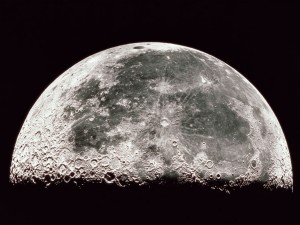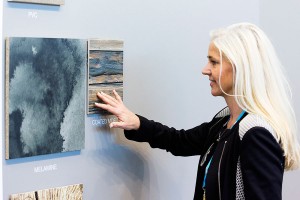The Author:
Rob is the Digital Marketing Co-Ordinator at the Genus UK Head Office
Metis Systems
From the moon to leading the digital wood décor revolution
Metis Systems is an Italian company that specialises in designing and manufacturing high quality scanners for the reproduction industry.
Massimo Colagrande, his brother Lorenzo and sister Silvia are Metis Systems owners and at the Decorative Surfaces Conference in Leipzig Massimo presented their revolutionary scanning technology for industrial digital decoration.
The company was started by their father Claudio and to this day he still supervises it while Massimo, Silvia and Lorenzo are respectively in charge of design, management and production along with highly skilled and experienced team of people. Massimo Colombo is Metis System’s sales director and was also present at the conference.
So Massimo ( Colagrande ), what do you do for the company?
“My role is to run the software, optical and electronic design. I am also responsible for designing the scanner together with my brother and the support of an electronics team and a mechanical team.
We have accumulated a high level of experience over many years working with digital satellite imagery and by working within the photographic industry.
This experience has been useful because Metis Systems now have a wide spectrum of knowledge in multiple disciplines related to digital imaging that places us in a unique position.
For instance, we now know about imaging sensors and not only confined to the visible colour range.
We also have knowledge in the multispectral and hyperspectral range.
We also have a deep understanding of lighting and optical laws that are required in order to be able to design top level digital cameras and scanners and are strong in image processing ( all Metis Systems software is made in-house ).
Just recently, the combination of all of this experience allowed us to design a unique Photometric Stereo algorithm that allowed our scanners to generate 3D data from colour images coming from our digital camera.
Photometric Stereo 3D is a sophisticated technique to derive 3D information from 2D information ( colour images ); its origin is from the early development of satellite imaging back in the 60’s. Work that had the aim of mapping the surface of the moon to aid the first satellite probes and ultimately the landings.”
So your business has a history light years away from digital printing?
“Yes! At the start of the space race NASA and the Soviet’s did not have the technology to be able to 3D scan the surface of the moon. To understand the surface and ultimately help exploration this was obviously important work.
They could not acquire 3D data directly so they tried to interpret colour or even grayscale images and then calculate 3D data from them and it was not simple or easy in anyway.
The first technique, from which later the Photometric Stereo was derived, was called Photoclinometry which in short is the ability to create a shape from shading and therefore calculate elevation data ( 3D data ) by analysing the shadows in the image.
Photometric Stereo is much more complicated than just shape from shading as it’s based on the idea of combining reflectivity information coming from different images acquired with different light direction ( i.e. different position of the sun ).
But because Photometric Stereo results were very dependent on the ability of controlling light direction and intensity, to be perfectly honest, it was not that effective while used on satellite imagery because it was of course not possible to control the position of the sun.
Furthermore, the mathematics behind it was hellish especially considering the computer processing power available at that time.
Then along came 3D dedicated devices and other techniques were introduced into satellite probes, and photometric stereo was kind of left in limbo as it became a bit redundant.
To compound this further, there was no real commercial application for Photometric Stereo 3D; one of the main reasons for this is the need for a strong control of the light source itself, therefore doing 3D outdoor using Photometric Stereo was virtually impossible and anyway indoor applications were also very limited because of the underlying mathematical model which is extremely complicated.
But in our case it was different. In our colour scanners we wanted to be able to do 3D and we had already a very sophisticated lighting and a good understanding of the principle behind the Photometric Stereo technique.
We also tried many other 3D techniques, utilising multi-stereo for example but the resolution was very poor. So I personally worked on developing our custom Photometric Stereo technique for ONE-1 and half 1/2 years as there wasn’t any good mathematical equations available and the few academic papers in existence didn’t really apply to us – think of the difference between sunlight and scanner light.
So the maths took some time. Finally after a year and a half we started having good results.”
So now you can successfully deal with mapping and then printing a 3D surface using industrial inkjet?
“Yes. Our scanning technology works really well by creating a 3D replica of a surface – the camera point of view does not change during the superscanning process and therefore we get 2D colour data, we calculate 3D data from it and can provide color+3D perfectly in register.
Furthermore, the resolution is amazing, in both colour and 3D, as we wanted to be able to see every fine detail of the surface and this is what the digital printing and decoration market needs.
To get perfect results, we had of course to fine control the lighting of the scanner but this this was relatively easy as in 2010, before even developing our 3D photometric stereo technique, we created and patented the DC SynchroLight technology and with this invention we could precisely control the amount and direction of the lighting in the scanning area; the SynchroLight was in fact mainly designed in order to provide 3D appearance to the scanned images, but it proved to be fundamental when we moved to real 3D.”
So why is it important to be able to print 3D for wood printing?
“Largely due to the value – a wood décor image must look great but then also feel good too. If you only have one of the two the value is not as high.
The haptic properties and the visual appearance are both important and I think we have really achieved a great result with this scanning technology.
To be honest in everything else I see on the market the quality and resolution our system provides is outstanding.
You could compare the 3D finish with that from a top 3D laser scanner.
Laser would be marginally more accurate, however it would take many hours or even days to 3D scan a wood, compared with ours which takes only a few minutes plus with ours you get full colour.
With our system you get calculated 3D, not measured, and the accuracy is very good at replicating surfaces but not so good into mapping real 3D objects.
It’s therefore designed for surface scanning not object scanning and is excellent in dealing with wood planks, stones, concrete, wallpaper, textile but also with difficult materials as metal parts, coins, glossy originals that you simply cannot acquire on a traditional 3D laser scanner.
How important is the ink?
In order to take this technological innovation onto another level it took a meeting of minds. Massimo Colombo, the sales director of Metis Systems met Giorgio Macor who runs Italian based ink innovator Kuei at an exhibition and Giorgio immediately saw the potential in developing a new ink for digital wood decoration. Macor explains, “We launched our Haptink last year at InPrint 2015 and the interest has been really amazing.
The demand for this kind of technology is increasing in line with the growth for customised production.
These days the requests have increased significantly for the ability to print 3D so you need something that is real 3D and for that you must have the right ink as well as software and scanning. We saw that potential very early. The 3D effect is one thing but with our ink you can also print colour which adds even more value.”
Massimo Colagrande continues, “What we have achieved with Kuei is a solution that can provide a very strong 3D visual and tactile impact which is of course very important.
What we do is flatten and optimise the 3D data so as to print just using the information that we want to sense. We therefore print embossing and colour information on top of it.
But if you print just a normal flat colour image it really doesn’t look optimal.
Therefore, best results are obtained printing a colour image with some level of 3D appearance on top of the embossing.
The visual appearance of the image is important because of the somehow limited embossing thickness, therefore from distance you already have a 3D feedback of the original then you go closer and you touch it and you get the feeling of it too.
But you need both, visual 3D and embossing ( real 3D ) to have the correct feeling and sensation of the material, this was the challenge and this is what we think we have solved on an industrial level.
“For digital printing there are not so many ink options.
Haptink is the first solution for this – we are talking about fast printing – single pass or fast multi-pass.
The embossing lays down one or two layers very thickly which is industrial quality and speed.
You could use another ink but the speed and quality of Haptink is just not comparable.
They would be OK for proofing but not for proper industrial digital speed.
And the good news is that the quality is improving all of the time as well. If you remember when digital photography came out the quality was not as good, but now it is excellent.”
So what does the future hold?
“We see increasing demand for high quality colour images and synchronised 3D data and this should come together more and more for surface decoration, not just 3D printing.
We saw a lot of people who were very excited as not everyone knew it was available.
And not only for the fact that it is possible but also because of other applications that may need that.
There was in fact also interest from people who come from other print aspects such as detecting defects or deterioration on print press plates as well as for other quality inspection purposes.
We also got requests from companies who are interested into using our Light Inspector software as a standalone and therefore in a more creative way for separating the scanning process from the optimisation of colour and 3D data ( probably to complete this crucial phase directly within their graphic/printing department ).
We already do that now, as for example when we send scan samples to Giorgio in order to make a print test, he gets a Metis Systems SuperScan file which he edits using our software to change the light direction and 3D appearance and of course also in order to optimise the 3D data before printing.
If he’s looking for a specific result we don’t have to rescan the original as the SuperScan file contains already all the needed information and this is very important and it makes things very easy, by helping not only to get a much better quality and visual/haptic impact but also to provide more variety to show to the customers.”
So from the moon to wood decoration, Metis Systems has evolved over time, and this innovative technology looks set to continue to evolve and develop revolutionising wood decoration and a host of other industries that are looking for customised surfaces for decoration.
In addition to the Low Entry Level METIS EDS Range of ALPHA & GAMMA Book & Flat Bed Scanners the METIS Range also includes the TOP OF THE LINE for Professional Applications METIS – DRS models of Flat Bed Scanners for Book/s & Large Format Documents which can scan material up to a Maximum of 2,000 x 1,210 mm = ( 78.7 x 47.64 inches ) or over DOUBLE A 0 + in size & up to 200 mm = ( 7.874 inches ) thick all of which integrate a ( Patent protected technology ) the DC SynchroLight – The perfect merging between extreme quality and productivity for the most demanding market. Designed for the quality scanning for Digitisation Projects of Oversize Material such as Drawing/s, Map/s, Papyrus, Scroll/s, Parchment/s, & also Book/s, Atlas/s, etc. plus Fine – Art, Decor and Professional Cartography applications.
In addition the METIS Systems Group now have added the METIS SUPERSCAN PM3D the first industrial scanner able to acquire Colour and 3D surface embossing based on new METIS PM3D® technology ( Patent protected ).
The SUPERSCAN PM3D ® is the first scanner to breach the resolution limits caused by the number of pixels in the imaging sensors thanks to an innovative opto-mechanical design that allows a native optical resolution of 1,200 PPI on the full scanning area ( 2,000 x 1,300 mm ).
Thanks to the Scan Merge tool scanning very large originals (exceeding the scanning area) is now also possible with perfect results. The SUPERSCAN PM3D ® adopt the new METIS Scan Director software that have been designed specially to fulfil the requirements of the industrial, fine-arts and decorative markets and for handling 3D data.
You may care to review the METIS Systems Group HOME PAGE – located online @ METIS Systems Group HOME PAGE




